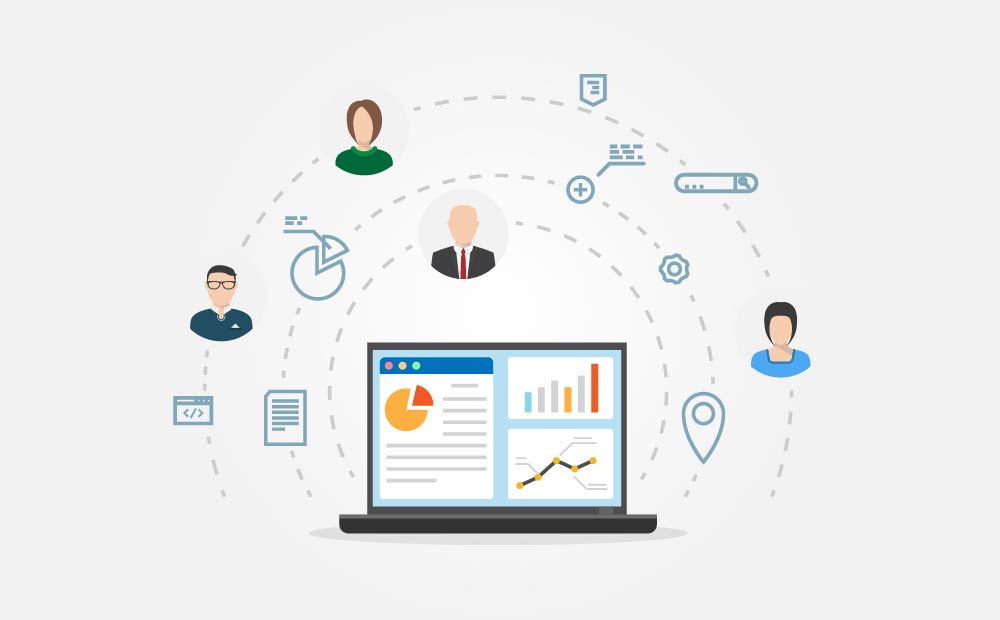The sales process is the method your company’s sales department uses to convert a potential customer into a real customer. A seamless sales process increases customer satisfaction and guides sales representatives.
Sales, which is one of the critical components of the business world, consists of a set of steps that require a particular method and discipline. A properly applied sales procedure increases your business volume and significantly increases the productivity of your employees. In addition, successful sales processes that improve sales teams’ performance make it easier for you to always reach high standards in customer experience. On the other hand, a functionally designed sales process also allows you to identify new leads.
In today’s working environment, where digital technologies are at the centre of business strategies, Customer Relationship Management (CRM) is an indispensable element of sales processes, building the sales processes supported by CRM software in a rational, consistent and open to development waypoints to a challenging journey. Mastering each step of this journey is crucial to achieving the best results.
What is the Sales Process?
The sales process, also called the sales procedure, refers to the methods your company’s sales department uses to convert a potential customer into a real customer. A seamless sales process increases customer satisfaction and guides sales representatives. The fact that the customers make the purchases in a way that will increase your profit share is directly related to the comprehensive process stages consisting of several different steps.
Stages of Sales Process
Each stage in the sales process, which consists of a series of sustainable steps, is necessary for you to communicate effectively with your customers. Skipping any of the steps, not being organised enough and not being managed well can cause you to experience financial losses. For this reason, you should arrange the whole process correctly. In addition, it would help if you did not forget that showing flexibility from time to time while adhering to your strategy can yield better results
The stages in the sales process consist of seven critical steps. The process in question may come in five or nine steps in different industries. Still, in general, a procedure where you will act in line with your customers’ needs, at the end of seven steps, gives you a detailed assessment of how to keep your current customers and how to communicate with potential customers.
Lead generation, preparation and investigation, needs analysis, presentation, objection management, closure and follow-up; are the seven primary stages of a successful sales process that will ensure you always go to the next level in customer relations. Furthermore, all seven relevant steps can be integrated with CRM programs ideal for generating unique sales opportunities and leads. Thus, you can make your entire strategy functional in the digital environment with the help of data analysis.
1. Creating Potential
The first stage of the sales process is lead generation. To create potential, you need to do extensive research. While researching, you try to reach potential customers and determine whether the audience you get needs any product or service you offer. The need of potential customers for your existing products is called competence. The level of possible competence directly affects your sales
The building block of end-to-end sales processes, CRM makes it easy to identify your customers accurately. In addition, CRM applications, which can create detailed profiles for potential customers using existing customer data, increase efficiency in the lead generation phase.
2. Preparation and Investigation
The second phase of the process, preparation and investigation, prepares your sales team for the first moment you sell to customers. Market research is also found at this stage. To deal with your company’s products and services more realistically, you should gather information about the market evaluations and the information piles formed by the users’ comments. The preparation and investigation phase is significant in this respect.
The process where you start to develop your sales presentation begins at this point. It would be best to consider the possible special needs of your customers as you begin the presentation development phase. Again, at the relevant stage, using new generation CRM systems that use cloud computing to determine the status of your products in the market and focus on your customers makes it possible for you to achieve better results
3. Needs Analysis
The needs analysis step reveals to what extent the product or service you offer meets your customers’ needs. You can create a unique sales opportunity in this step, including the process where you will define your product. At every stage of the third step, you should react appropriately to the needs communicated to you by the customers or reached through the multi-sales management line of the CRM.
4. Presentation
The presentation also called the approach stage, is when you first contact the customer. While you can organise a face-to-face meeting, you can also turn to online interviews during the communication process. There are three common approaches to presentation
The first method is to give your potential customer a free sample or demo version of the product or service you plan to offer. It is recommended that you proceed to this stage by ensuring that you do not make any mistakes in the needs analysis stage, as the prospect will review the product you have given. The other two methods offer gifts and ask questions about the customer’s need or service.
5. Objection Management
Objection management is the stage where your potential customers express their concerns about the product or service you offer, and you respond to those concerns. Successfully managing the objections to your product in the communication you have with the customers is one of the crucial factors determining the difference between the quality of the sales teams
It should be noted that CRM software plays a significant role in successfully implementing objection management. Promising a successful customer relationship management with data analysis, new generation CRM applications make it easier for you to create insights into the strengths and weaknesses of your product. CRM, which reveals the relevant predictions in the light of the current data and expectations of the potential customer, ensures that you are ready before the customer voices his objection about the product. The feature strengthens insights into your company and makes your brand identity more valuable.
6. Closing
At some point, the sales process has to be decided. Then, based on the data you obtained through the communication you have with your customer and the CRM system, you can follow one of the alternative options, additional incentives and definite-time closing methods. The alternative option relates to the form of payment where the sale is final. Extra incentive means free to use or discounts valid for a certain period. At the same time, the fixed-time method indicates creating urgency about the price or use of the product.
7. Follow-up
Companies sometimes do not put too much emphasis on the follow-up phase. This causes problems in the evaluation process of the returns regarding the sale. The follow-up phase, also called the monitoring phase, includes the long-term observation of the consumption, business and purchasing behaviours of people or companies that turn from potential to existing customers because retaining existing customers is much less than reaching potential customers.
All seven stages in the sales process are directly related to the structure and advantages of new generation CRM software. So if you want to build a successful sales process by focusing on all of the customer, revenue, opportunity, foresight and business topics, you can immediately get an offer for our cloud-based and sales-oriented CRM software, FowCRM, which offers end-to-end solutions.
FowCRM, a BilgeAdam Technology brand, works with a subscription model, is user-friendly, has a multi-user feature and provides multi-language support.
Relationship Between CRM and Sales Processes
Being an indispensable element of a successful sales process, CRM is one of the essential digital solutions your company needs on the way to success. The new generation CRM software, which allows you to define your customers and their needs accurately, also makes it easier to understand your product’s features. In this way, you can communicate better with the customer and use the feedback you receive about your product in development studies.
CRM software gives you an extensive database of your customers. Considering how significant the effect of proper communication in the sales process is, reaching your customers quickly with the help of the data in the database of the CRM software increases your sales ability.
Promising numerous benefits in converting potential customers into customers; retains all data about the sales process and your customers. In the light of the said data, it prepares analyses, prepares sales reports and creates cost tables. In addition, CRM systems that store the data of your previous customers allow you to make sales forecasts for the future.
In other words, a successful Customer Relationship Management application contributes to the improved customer experience through its different features at all stages of the sales process. When you integrate next-generation CRM software into your sales strategy, it becomes easier to communicate well, develop customer loyalty, drive sales, and increase the efficiency of sales teams.
Benefits of CRM in the Sales Process
CRM allows you to control the entire sales process from a single point. You can access the CRM system, which helps you view the data of your customers in detail, from anywhere, anytime. It is sufficient to have an internet connection to use CRM software that uses cloud computing infrastructure.
Better communication between your sales teams is also among the benefits of CRM. But on the other hand, you can manage all of your sales transactions and offers through CRM, perform data analysis, and strengthen your sales process with the reports you create due to a more accurate evaluation.
Today, 91% of companies with more than 11 employees use CRM software. According to the data obtained from the companies in question, a new generation of CRM software; increases sales by 29%, productivity by 34% and forecast accuracy by 42%. In addition, 65% of companies using a mobile CRM software manage to reach their sales targets, while the return on investment of CRM is $8.7 for every $1.
FowCRM: User Friendly Next Generation Customer Relationship Management
FowCRM makes it easy to focus on your customers with its multiple sales management pipelines. The software, which provides access from anywhere and from any device, can be used in integration with different applications. According to your needs, you can customise the platform, which offers multi-language and currency support. Preventing you from having problems with GDPR compliance and regulations for data usage, FowCRM saves time with automation.
Achieving high sales values is to build a successful sales process. The way to make a successful sales process is to correctly implement all the steps from generating potential to closing with FowCRM. In addition, thanks to FowCRM, which includes the Invoice and Payments feature, you can make accurate financial decisions and effortlessly manage your payment plans. Standing out with its data analytics and reporting features, FowCRM focuses on insights, allowing you to view the process from the same window as your customers. This increases your sales, productivity and profitability.
If you want to make your company’s sales processes more efficient, be flexible, establish better relations with your customers and make the relations you have established sustainable; you can purchase our FowCRM product.
You can contact us to learn everything you want to know about FowCRM, which is under the umbrella of BilgeAdam Technology, get information about possible customizations specific to your company, and receive price quotes at four different levels.




